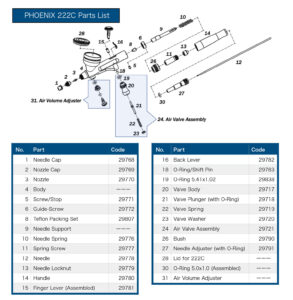TROUBLESHOOTING
YES! THE BRUSH MAKES A DIFFERENCE
It all begins here. You ABSOLUTELY have to have a brush that is capable of putting down the type of detail that you hope to achieve. I do not agree with the common theory that as a beginner you don't deserve a quality brush. I am not saying that it is necessary to go out and buy the absolute top of the line, but you are not going to do yourself any favors buying a brush that will fight you and discourage you from moving forward and actually learning how to airbrush.
There are a lot of good brushes out there. Every manufacturer has quality brushes, but you will generally NOT find them at the low end of the pricing scale. I cannot stress this enough. You need to have a brush that is capable, or you will become discouraged.
Obviously I have worked with RichPen directly to manufacture the PHOENIX 222C and I further refine every MOJO+ to produce what I think is the finest, most capable brush on the market. It has a full polish and is completely tuned to be able to perform when I ask it to. The RichPen MOJO+ is my choice for detail, period.
For similar performance at a truly affordable price, my MoBro+, a completely polished and tuned RichPen APOLLO, is truly second only to its Big Brother MOJO.
PAINT VISCOSITY IS KEY
If the paint is too thick, you will not get immediate paint response. If this is the case, you will need to further refine the mix. If your paint is too thin, you will not have the body of pigment that you need to paint. You should not have to go over your lines 3-4-5 times to establish the design. If you do, you need more pigment. Proper reduction IS THE ONLY WAY to get a brush as precise as the RichPen MOJO+ USA to work at its ultimate potential.
My perfect paint mix is:
* 1:1 slow speed/medium reducer
* Fill the cup halfway and top off with lacquer thinner
*** This will vary with the type of paint you use. With the RichPen MOJO+ I have found myself reducing even more, and having even less blow out than previous models. ***
The speed of the reducer is important as well. In our climate, I use slow speed reducer pretty much exclusively. In colder climates, you may need to change to medium. For airbrushing I would rarely, if ever, recommend fast speed reducer, especially if you are working on clear coat. Using fast reducer on clear will not give you the chemical etch that you need for your work to last. Base coat is more forgiving in this sense, but still, I do not recommend fast reducer for airbrushing.
If you are using too fast a reducer, you will note that your fine spray will come off when tacking your work. If you are experiencing this problem with medium reducer, you should change to slow. If your reducer is too slow, you will note that your hand or a loose hand shield will smear or imprint your work as you paint. If you experience this issue while using slow reducer, you should consider moving to a medium.
As you know, I work primarily with urethane, however mix applies to water based paint as well, just using different products to reduce and refine.
AIR PRESSURE MATTERS
the main symptom of improper air pressure bad atomization. If your paint mix is good and you are getting immediate paint response, but it is grainy, you need to address your air pressure. Unfortunately, there is no magic number for air pressure, it is different for different paint/surface/brush combinations. I range in pressure from 20-40 psi, settling in at about 25 for the bulk of my work. I will raise the pressure for large fills or background work.
One of the major, and most exciting improvements to the RichPen MOJO+ is the new Air Volume Adjustor. This feature allows you to have instant and extremely precise control of the airflow to your brush. Utilizing the precision knob you can make minor adjustments on the fly eliminating the need to adjust your main regulator for pressure differences you may need as you work on a job.
In reality, all 3 of these items, the brush, viscosity and air pressure, work together simultaneously, and affect each other with each and every adjustment. There is no magic combination that you can dial in and go. You have to work with your brush and your products to find what works for you. Take these things into consideration, all equally as important, as you look for your own "sweet spot".

